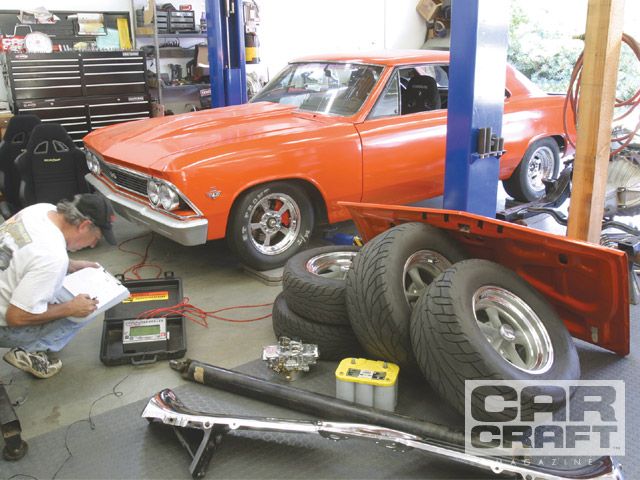
The 11 o'clock news talks about it all the time: America is fat-overweight-rotund-and we couldn't agree more. But we're talking about carburetors and muscle cars, not carbohydrates and Lean Cuisine. Over the past few months, we've put a lot of time into our Orange Peel Chevelle, including new paint, a California Performance Transmission 200-4R overdrive, and a pavement-pounding trip between Los Angeles and Phoenix on the CC Anti-Tour. All these efforts were so successful that now we're motivated to push the orange crusher deeper into the 11s. While installing a new shifter, we uncovered a load of factory sound deadener under the carpeting. After yanking out all that sticky stuff, we were shocked to discover the nasty pile weighed 20 pounds. That got us thinking about what else we could do to lighten the car. We then discovered that the partly lightened Chevelle weighed a mere 3,221 pounds and decided right then to trim Orange Peel down to a lean and mean 2,990 pounds.
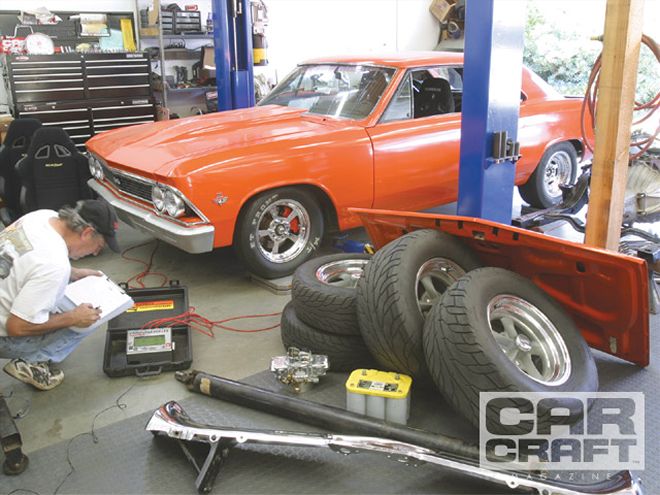 We spent way too much time weighing almost everything we could get our hands on in a quest to reduce weight.
We spent way too much time weighing almost everything we could get our hands on in a quest to reduce weight.
If this car were a dedicated drag race car, we'd replace all kinds of stuff with oh-too-thin race fiberglass and plastic. But the Chevelle is first a street car. Sure, we've compromised by stripping the A/C, heater, blower fan, and even the windshield wipers, but frankly, we live in Southern California and don't plan on driving the car in the rain. We've come up with what we think are some creative solutions that might give you ideas on ways to trim the fat. Keep in mind that the classic tale of 100 pounds is equal to a tenth of a second and 1 mph is still right on target. We might have gone a bit beyond practical, but you can pick and choose the ideas that best help you to lose a few pounds-and trim the e.t. at the same time.
CC Diet Step 1
We started off by eliminating the heavy parts like the tar paper insulation, A/C, and heater assembly. Then we got into substituting heavy with light. The trick is to do this without spending a lot of money or destroying the car's street manners. In some cases, we were successful and in other cases, the light stuff cost more than we'd anticipated. The chart shows how much initial weight we pulled out of the car. We found it easier to look for 20 places to remove 5 pounds than one place that was worth 100. We needed to trim lots of weight because we also added 100 pounds to the car with an eight-point, Art Morrison, mild steel rollbar assembly. Many of the early parts added were done several years ago, so we don't have a really accurate starting weight, but a typical all-steel '66 small-block Chevelle with A/C weighs around 3,510 pounds without a driver. We also weighed a drum-brake '67 Chevelle small-block that came in at 3,400 pounds, so there is some variation.
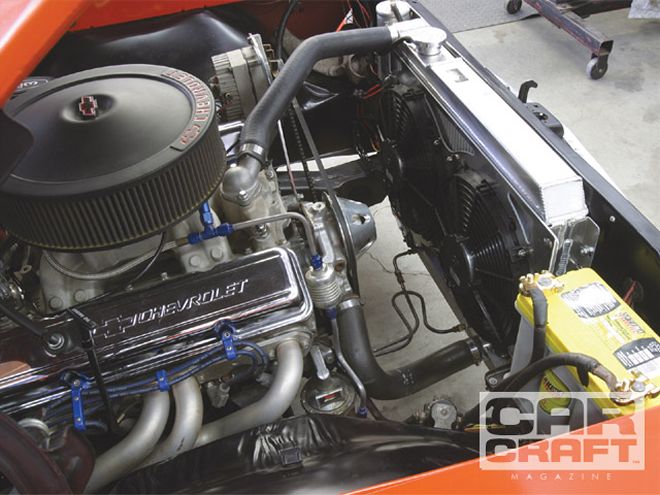 This large Be Cool aluminum radiator and a pair of Spal electric fans definitely trimmed some fat. If you're really fanatical, Be Cool makes single-core drag race radiators, but we needed the capacity for a 496 Rat that's destined for this car.
Weight Chart
Starting Weight: 3,510
Heavy Parts
Weight
Light Parts
Weight
Savings
Steel hood
54
Fiberglass hood
20
34
Steel front bumper
26
Fiberglass bumper
2
24
A/C equipment
80
A/C-delete fiberglass
1
79
Front bench seat
84
Two bucket seats
70
14
Rear bench seat
11
Rear seat removed
0
11
Brass copper radiator
34
Be Cool radiator
17
17
Sound deadener
20
Removed
0
20
Stock starter motor
20
GMPP light starter
9
11
Clutch fan
8
Removed
0
8
Brake booster
6
Removed
0
6
Stock radio
10
Aftermarket
2
8
Cast-iron manifolds
25
Headers
15
10
Cast-iron intake
20
Aluminum intake
4
16
15x8 steel wheels
100
Aluminum wheels
60
40
Power steering
34
Manual
13
21
Trunk mat
10
Removed
0
10
Stereo speakers
30
Removed
0
30
Spare tire
30
Removed
0
30
Weight savings
389
Weight added-AME eight-point rollbar (chrome-moly, 72 pounds)
100
Net weight savings
289
Weight with half a tank of fuel
3,221
This large Be Cool aluminum radiator and a pair of Spal electric fans definitely trimmed some fat. If you're really fanatical, Be Cool makes single-core drag race radiators, but we needed the capacity for a 496 Rat that's destined for this car.
Weight Chart
Starting Weight: 3,510
Heavy Parts
Weight
Light Parts
Weight
Savings
Steel hood
54
Fiberglass hood
20
34
Steel front bumper
26
Fiberglass bumper
2
24
A/C equipment
80
A/C-delete fiberglass
1
79
Front bench seat
84
Two bucket seats
70
14
Rear bench seat
11
Rear seat removed
0
11
Brass copper radiator
34
Be Cool radiator
17
17
Sound deadener
20
Removed
0
20
Stock starter motor
20
GMPP light starter
9
11
Clutch fan
8
Removed
0
8
Brake booster
6
Removed
0
6
Stock radio
10
Aftermarket
2
8
Cast-iron manifolds
25
Headers
15
10
Cast-iron intake
20
Aluminum intake
4
16
15x8 steel wheels
100
Aluminum wheels
60
40
Power steering
34
Manual
13
21
Trunk mat
10
Removed
0
10
Stereo speakers
30
Removed
0
30
Spare tire
30
Removed
0
30
Weight savings
389
Weight added-AME eight-point rollbar (chrome-moly, 72 pounds)
100
Net weight savings
289
Weight with half a tank of fuel
3,221
Time To Get Serious
This is when we decided to get fat-alistic. We had to find a way to chisel another 230 pounds to get our A-body less than 3,000. After the rearend test in the June '08 issue ("The Great Rear Axle Comparo"), we retained the Strange S60 rearend for its durability. But the prospect of dropping 20 pounds demanded the 12-bolt's return. Substituting a California Performance Transmission 200-4R for the original TH400 also netted 14 pounds ("Transformation," Sept. '09). Next we started looking at small, individual components that included a Wilwood aluminum master cylinder, a smaller Optima battery, and we even resorted to making aluminum bumper brackets for the fiberglass bumpers. While searching through GlassTek's catalog, we also replaced the steel decklid with fiberglass. This dropped 25 pounds, even if it was off the wrong end of the car. This is not ideal, but at this point we just wanted to cut weight anywhere we could.
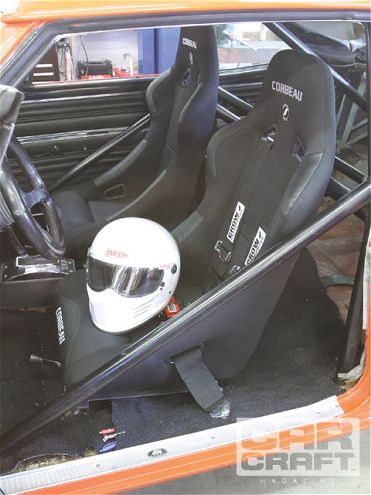 We found a pair of Corbeau fixed-back Forza seats at 19 pounds each plus the mounting brackets at 6 pounds, saving another 20 pounds. We also added the Crow safety harnesses and a Simpson Bandit helmet to keep us safe during those 11-second quarter-mile blasts.
We found a pair of Corbeau fixed-back Forza seats at 19 pounds each plus the mounting brackets at 6 pounds, saving another 20 pounds. We also added the Crow safety harnesses and a Simpson Bandit helmet to keep us safe during those 11-second quarter-mile blasts.
The biggest gain of this entire effort was the tire and wheel package. This is also where we cheated a little bit. Our before weight included a typical street tire and wheel package using a set of 15x7-inch front and 15x8-inch rear Rocket five-spoke Fuel Gray wheels mounted with a pair of 28x10-15-inch Mickey Thompson Sportsman S/R radials in back and 26x6-15 M/T front tires. The larger rear tires are hefty at 27 pounds each, putting the pair of rear tires and wheels at just below 100 pounds. To reduce this bulk, we dug into the Mickey Thompson catalog and found a set of forged, strip-only, aluminum ET Drag wheels. For the front, we used a pair of 15x3.5-inch wheels mounting a pair of 26-inch-tall ET Front tires that barely weigh anything. On the rear, we opted for the DOT-legal 26x10.50-15 ET Street tires mounted on 15x8-inch ET Drag wheels that are a svelte 31.5 pounds each. This shaved an amazing 70 pounds off the car. Not only is this a huge static weight improvement, but accelerating a much lighter wheel and tire package frees more power to accelerate the car. We also chose the ET Street tire because the bias-ply tires are much lighter.
Weight Chart Starting Weight: 3,221 Heavy Parts Weight Light Parts Weight Savings Street tires, front, pair 76 Race wheels/tires, pair 41 35 Street tires, rear, pair 98 Race wheels/tires, pair 63 35 Dana 60 rearend 230 12-bolt rearend 210 20 TH400 trans 179 200-4R overdrive 165 14 Optima Yellow Top 41 Optima D51 25 16 Bucket seats (2) 70 Corbeau seats (2) 50 20 Front bumper brackets 5 Aluminum brackets 0 5 Rear steel bumper 20 Fiberglass rear bumper 2 18 Rear bumper brackets 4 Aluminum brackets 0 4 Steel decklid 37 Fiberglass decklid 12 25 Cast-iron master cylinder 9 Wilwood aluminum 2 7 Rear glass 12 Percy's Speedglass 8 4 Quarter-window/regs 15 Percy's Speedglass 5 10 Stereo head unit 1 Eliminated 1 E-brake pedal assembly 2 Eliminated 2 Spal 12-inch twin fans 30 Spal twin 11-inch fans 25 5 Steel driveshaft 19 Aluminum driveshaft 12 7 Net weight savings 228 Race weight of car with half a tank of fuel 2,993The Four Corners
After we installed all the lightweight parts, the final test was to put the Orange Peel Chevelle back on the Longacre four-wheel scales to see if we made our weight. As you can see from the above graphic, we achieved our goal of trimming the Chevelle to our 2,993-pound race weight. This is without driver, which we also plan to cheat by putting staffer John McGann in the driver seat, who weighs almost 50 pounds less than the author. This would put the Chevelle's starting line race weight at around 3,150 pounds.
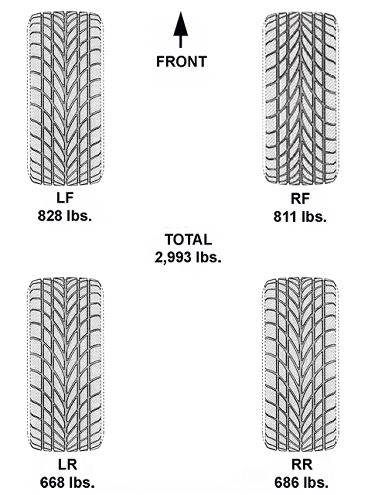
The weight distribution of the car without the driver calculates out to 55 percent front and 45 percent rear, which is admitedly less than ideal. We could improve that by moving the battery to the rear or eventually adding a Dick Miller-designed rear sway bar system to improve dynamic launch characteristics. We also evaluated the left-right weight distribution, which without the driver, is within 1 pound. However, when we add driver weight, most of that weight ends up on the wrong side of the car. This means we have more work to do to create a more even distribution of weight.
PARTS LIST Description PN Source Price AME eight-point rollbar, Chevelle 20206100 Art Morrison $315.00 Wilwood aluminum master cylinder 26094390 Art Morrison $180.00 Axle Exchange driveshaft custom Axle Exchange $500.00 Axle Exchange 1350 12-bolt flange custom Axle Exchange $169.50 Corbeau Forza fixed-back seats Forza black Corbeau $229.00 each Corbeau Chevelle mount, driver D512T Corbeau $94.00 Corbeau Chevelle mount, passenger D513T Corbeau $94.00 Glasstek 2-inch bolt-on cowl hood H1108 Glasstek $420.00 Glasstek bolt-on trunk lid T1043 Glasstek $320.00 Glasstek front bumper B1026 Glasstek $180.00 Glasstek rear bumper B1006 Glasstek $180.00 Percy's Speedglass quarter-window 01015-3 Percy's $133.10 Percy's Speedglass quarter-window 01014-3 Percy's $133.10 Mickey Thompson race front wheels 75355071 Summit Racing call Mickey Thompson race rear wheels 658050754 Summit Racing $349.95 Mickey Thompson ET Street rear 3752 Summit Racing $175.95 each Mickey Thompson ET Front tires 3007 Summit Racing $148.95 each Optima D51 battery 9071-167 Summit Racing $149.95 Be Cool radiator and fan assembly 82285 Summit Racing $1,599.95 Percy's Speedglass rear window 01016-3 Summit Racing $412.95 Simpson Bandit driver's helmet 1200031 Summit Racing $399.95 Holley aluminum Avenger 770 0-86770 Summit Racing call